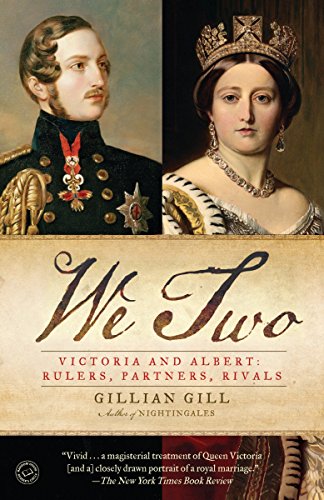We Two: Victoria and Albert: Rulers, Partners, Rivals / Gillian Gill,
| List Price: | |
Our Price: $18.15 | |
|
For Bulk orders
| |
|
Used Book Price: | |
| We Two: Victoria and Albert: Rulers, Partners, Rivals / Gillian Gill, | |
| Publisher: Ballantine Books | |
| Availability: | |
| Sales Rank: 459675 | |
|
It was the most influential marriage of the nineteenth century--and one of history’s most enduring love stories. Traditional biographies tell us that Queen Victoria inherited the throne as a naïve teenager, when the British Empire was at the height of its power, and seemed doomed to find failure as a monarch and misery as a woman until she married her German cousin Albert and accepted him as her lord and master. Now renowned chronicler Gillian Gill turns this familiar story on its head, revealing a strong, feisty queen and a brilliant, fragile prince working together to build a family based on support, trust, and fidelity, qualities neither had seen much of as children. The love affair that emerges is far more captivating, complex, and relevant than that depicted in any previous account.
The epic relationship began poorly. The cousins first met as teenagers for a few brief, awkward, chaperoned weeks in 1836. At seventeen, charming rather than beautiful, Victoria already “showed signs of wanting her own way.” Albert, the boy who had been groomed for her since birth, was chubby, self-absorbed, and showed no interest in girls, let alone this princess. So when they met again in 1839 as queen and presumed prince-consort-to-be, neither had particularly high hopes. But the queen was delighted to discover a grown man, refined, accomplished, and whiskered. “Albert is beautiful!” Victoria wrote, and she proposed just three days later.
As Gill reveals, Victoria and Albert entered their marriage longing for intimate companionship, yet each was determined to be the ruler. This dynamic would continue through the years--each spouse, headstrong and impassioned, eager to lead the marriage on his or her own terms. For two decades, Victoria and Albert engaged in a very public contest for dominance. Against all odds, the marriage succeeded, but it was always a work in progress. And in the end, it was Albert’s early death that set the Queen free to create the myth of her marriage as a peaceful idyll and her husband as Galahad, pure and perfect.
As Gill shows, the marriage of Victoria and Albert was great not because it was perfect but because it was passionate and complicated. Wonderfully nuanced, surprising, often acerbic--and informed by revealing excerpts from the pair’s journals and letters--We Two is a revolutionary portrait of a queen and her prince, a fascinating modern perspective on a couple who have become a legend.
Amazon Exclusive: An Essay by Gillian Gill When I was growing up in South Wales, the part of Great Britain best known for coal mines, people like me did not write about royalty. We left that to “nobs” like Countess Longford (alias Elizabeth Longford) who were actually invited to coronations or to people like Cecil Woodham-Smith whose double-barrelled surname and weird given name proclaimed her membership of the elite public (i.e. private) school set. My family was the kind that lined the route on a rare royal visit to our provincial city, waving tiny union jacks.
When I was growing up in South Wales, the part of Great Britain best known for coal mines, people like me did not write about royalty. We left that to “nobs” like Countess Longford (alias Elizabeth Longford) who were actually invited to coronations or to people like Cecil Woodham-Smith whose double-barrelled surname and weird given name proclaimed her membership of the elite public (i.e. private) school set. My family was the kind that lined the route on a rare royal visit to our provincial city, waving tiny union jacks.
Until my teens, my sister Rose and I were reared jointly by our mother and her mother. Mummy and Nana lived together all their lives, quarreled every day, but shared a passion for the British royal family. In our house, the pantheon of royals was worshipped with more fervor and regularity than we mustered at the plain little branch of the Church of Wales just around the corner. The royals were glamour and romance, items severely rationed in post-war Britain.
1953, the year of Queen Elizabeth II’s coronation, was a banner year for our family. My mother bought a television set and invited her humbler relatives over to squint at the magnificent event on our twelve inch, black and white set. There followed a street party and my grandmother, who had once apprenticed as a milliner, contrived marvelous costumes for Rose and me. I was actually queen for the day with a long white dress, purple robe, and crown, orb, and scepter.
But once my father retired from the Merchant Navy and took his place in the family, his carefully informed left-wing politics took hold of me and my grandmother’s reverence for the royal family began to seem silly and ignorant. When I was about seventeen, I made some flip remark about the abdication of King Edward VIII which so infuriated Nana that she slapped my face. At the time I was shocked and wholly at a loss. Now I think I understand. A handsome and engaging young king had once come to South Wales and spoken movingly of the plight of the miners. Women of my grandmother’s generation had never forgotten it. Like the rest of the general public in Britain, she had been carefully shielded by the press from any knowledge of Edward VIII’s prenuptial dalliances and fascist opinions.
By 1965 I was a graduate of Cambridge University, the first of my family to attend university and a budding academic. When it was announced that the Queen Mother would come to New Hall, my Cambridge college, to open the new buildings, I was blasé to the point of disdain. But when I found myself curtseying and carefully shaking the tips of Her Majesty’s gloved fingers, I was swept away by the mystique of royalty. How delightful the Queen was in person and how proud my grandmother would be when she saw the photo of me with the Queen Mum.
All of which is to explain why my book about Queen Victoria is prefaced by the old English saying: “A cat may look at a king.” --Gillian Gill
(Photo © Linda Crosskey)
A Look Inside We Two |  |  |
Now you can buy Books online in USA,UK, India and more than 100 countries.
*Terms and Conditions apply
Disclaimer: All product data on this page belongs to
 .
.No guarantees are made as to accuracy of prices and information.










